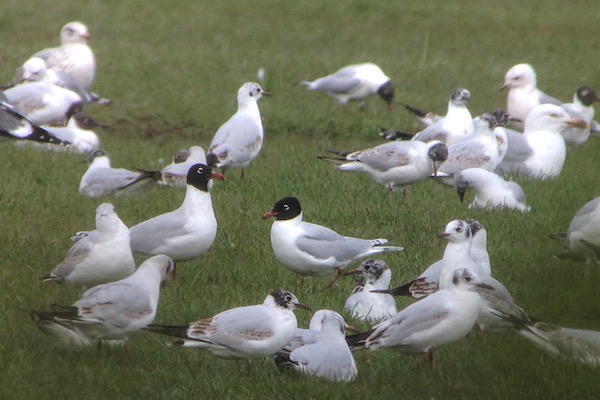Checking the gull flock there was initially no sign but I picked one up on call circling round and the next day there were three birds in the flock. Two (a second summer and an adult bird) were obviously paired up whilst the third kept its distance.
Great to see them locally on my patch and even better, from the garden!
The history of this striking gull in the UK is interesting:
The species was formerly a great rarity in Britain with only four or five records before 1940 and the BBRC accepted ten records in 1958, its first year of adjudicating rare birds, but ceased to consider records after 1962. Since then, there has been a rapid increase in the number of records and breeding was confirmed for the first time in Hampshire in 1968. There has been a slow and steady increase in the breeding population since then and between 90 and 104 pairs bred in 2001, the majority in southern England. Events in Britain have mirrored those in Europe and it is likely that the breeding population will continue to increase over the coming years; similar events occurred in France where the breeding population increased from over 100 pairs in 1991 to nearly 1,400 pairs by 1998. The wintering population of Britain is put at over 1,200 birds with over 100 in Ireland.
Although not a rarity, a summer-plumaged Mediterranean Gull is a match in looks for any of the rare gulls to occur in Britain and Ireland. Despite increasing numbers, away from the south coast the species is scarce enough to make finding a 'Med Gull' in your local gull flock or gull roost a notable event.
Globally, the distribution of this striking gull is restricted to a few localities in Europe, most particularly in the northern part of the Black Sea, where 245,000 pairs breed in the Ukraine. Elsewhere, it has a fragmented distribution across Europe, with the northwestern limit in Britain and Ireland. The world population is put at between 120,000 and 300,000 pairs, 99% of which are in the former USSR. The main wintering area is in the Mediterranean where up to 700,000 winter, most in the southern Mediterranean. Smaller numbers can be found in western and northwest Europe to southern Scandinavia. Ringing studies have highlighted the use of the large river systems to facilitate movement.
As with other gulls, colour-ringing is starting to provide an interesting picture of the movements of birds throughout Europe. The Migration Atlasreported the origins of some of the birds present in Britain and Ireland where 11 were from The Netherlands, five from Germany, three from Hungary and one from the former Yugoslavia.(Birdguides).
With breeding or attempted breeding by a small number of birds over the last few years in Cheshire it looks like these birds will feature more regularly in any large flock of gulls.
A number of colour ringed birds have been recorded in consecutive winters on the N Wirral Coast and the first Mediterranean Gull for Cheshire and Wirral was recorded as recently as 1967 and from then in every subsequent year.





























































No comments :
Post a Comment